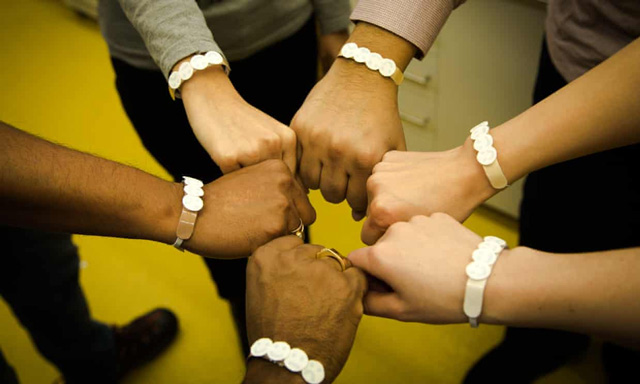Ultraviolet warning bracelet
To protect people from the harmful effects of ultraviolet rays (or UV rays) in the sun, scientists at RMIT University (Australia) have created a type of UV safety warning bracelet.

Australian researchers have successfully developed a color-changing paper when exposed to ultraviolet rays.Photo: RMIT University / Nature.
The bracelet is simply designed, including a paper sensor that draws smiling faces and grimace faces. A special feature is that the drawings on it use UV-sensitive inks prepared by the researchers themselves.
This is considered a simple and convenient solution, does not require high technology to help users know when to avoid the sun. The team has also created several bracelet versions for different skin tones, because skin tones are a very important factor affecting each person's UV resistance. People with darker skin are better able to withstand ultraviolet rays, the duration of injury is longer, but the frequency of sun exposure needed to absorb vitamin D is much higher.
In addition, the bracelet sensor is able to respond to different UV radiation levels: UVA is associated with the risk of skin aging and wrinkle formation, while UVB rays are the main cause. sunburn and lead to skin cancer.
According to Professor Vipul Bansal, research author from RMIT University, people are often afraid of sun exposure for too long due to concerns about the risk of skin and eye diseases such as cataracts, cancer or skin aging; but if we don't get enough exposure to the sun, we also face the risk of vitamin D deficiency.
Although weather reports often have an accompanying UV index that shows the ultraviolet radiation level at the time of reporting, they do not indicate the safe limit for sun exposure. This safety limit is not only assessed on numbers but also depends on the differentiation of skin pigmentation of each person.
The ink on the hand is a mixture of phosphomolybdic acid, or PMA and lactic acid. When exposed to ultraviolet and lactic acid at the same time, colorless PMA turns green. The ink mixture is drawn on transparent paper used for overhead projectors. This type of paper allows researchers to adjust the density of UV exposure to the skin by creating layers of different thicknesses, so that face drawings change color according to the corresponding sun exposure levels from 25 %, 50%, 75% and 100%.
The study also found that PMA ink when exposed to UVB rays will produce a darker green color when exposed to UVA during the same time period. This indicates that the higher the exposure to UVB in the sun, the faster the sensor will reach 100% radiation warning. Thanks to the adjustment of the sensor paper layers, the scientists created several bracelet versions for 6 different skin tones.
After initially designing with the ultraviolet light in the lab, the bracelets are being tested in the external environment. The team hopes the bracelets will soon be available in the market next year for only $ 1.
- Netherlands develops seizure warning bracelets
- He developed a bracelet that recognizes user emotions
- Introduce the shark shark bracelet
- Bracelet detects poor teacher
- Things to know about ultraviolet (UV)
- Electronic bracelet for pilgrims to Mecca
- The oldest bracelet in the world
- Video: Alcohol alert bracelet for drinkers
- The bracelet catches dirty guys
- Smart bracelet helps police prosecute the husband suspected of killing his wife
- 5 ultraviolet environments much less expected
- Hand made wristbands contain toxic substances
 'Fine laughs' - Scary and painful torture in ancient times
'Fine laughs' - Scary and painful torture in ancient times The sequence of numbers 142857 of the Egyptian pyramids is known as the strangest number in the world - Why?
The sequence of numbers 142857 of the Egyptian pyramids is known as the strangest number in the world - Why? History of the iron
History of the iron What is alum?
What is alum?